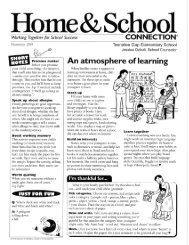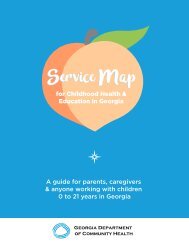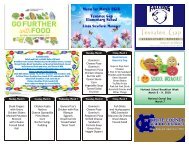MAP Parent-Guide
You also want an ePaper? Increase the reach of your titles
YUMPU automatically turns print PDFs into web optimized ePapers that Google loves.
The Results: Your Child’s RIT Score<br />
RIT scores have the same meaning across grade levels.<br />
If a fourth-grade student and an eighth-grade student<br />
have the same RIT score in reading, then they are testing<br />
at the same level in that subject.<br />
You can use your child’s RIT score to help them meet<br />
their goals. For example, students can enter their RIT<br />
scores into our college explorer tool to see which<br />
colleges and universities they’re on track to enter. You<br />
can also check out online resources that use RIT scores<br />
to provide students with book recommendations and<br />
web-based exercises, such as yourreadingpath.com and<br />
khanacademy.org.<br />
“<strong>MAP</strong> Growth is important because<br />
it allows my teacher and me to see<br />
how much I know and my percentile<br />
growth. In math, my score used to<br />
be 227 (70th percentile), but it is<br />
now 240 (87th percentile). I didn’t<br />
know I was capable of so much<br />
growth, but in the end I was.”<br />
Kayla, 6th grade<br />
Santa Ana, CA<br />
COMMON QUESTIONS<br />
How do schools and<br />
teachers use <strong>MAP</strong><br />
Growth scores?<br />
Teachers can use the score to inform instruction, personalize learning, and monitor the<br />
growth of individual students. Principals and administrators can use the scores to see the<br />
performance and progress of a grade level, school, or the entire district.<br />
Can <strong>MAP</strong> Growth<br />
tell me if my child is<br />
working at grade level?<br />
Yes, but please note that <strong>MAP</strong> Growth scores are just one data point that teachers use to<br />
determine how a student is performing. Please discuss any questions that you have about<br />
your child’s performance with your child’s teacher.<br />
How often will my child<br />
take <strong>MAP</strong> Growth tests?<br />
Most schools give <strong>MAP</strong> Growth tests to students at the beginning, middle, and end of the<br />
school year (in the fall, winter, and spring). Some schools choose to administer tests only<br />
twice a year.<br />
What are norms?<br />
NWEA provides schools with norms every three years. This is anonymous data from more<br />
than 10 million students around the country. Knowing the top, middle, and bottom scores<br />
of all these students combined allows teachers to compare where your child is to other<br />
students and help them grow.<br />
Is <strong>MAP</strong> Growth a<br />
standardized test?<br />
Unlike a standardized test, <strong>MAP</strong> Growth is administered periodically during the school year.<br />
Instead of asking all students the same questions, it adjusts to each child’s performance—<br />
giving a more accurate measure of what they know. Teachers also receive results right<br />
away, which enables them to react more quickly.<br />
What types of<br />
questions are on<br />
<strong>MAP</strong> Growth tests?<br />
The <strong>MAP</strong> Growth tests include multiple choice, drag-and-drop, and other types of<br />
questions. For sample tests, visit warmup.nwea.org.<br />
For tips on getting ready for <strong>MAP</strong> Growth testing, check out our blog:<br />
nwea.org/blog/category/parents<br />
Find more parent resources at nwea.org/parent-toolkit<br />
NWEA® is a not-for-profit organization that supports students and educators worldwide by providing assessment solutions, insightful reports,<br />
professional learning offerings, and research services. Visit NWEA.org to find out how NWEA can partner with you to help all kids learn.<br />
© NWEA 2017. <strong>MAP</strong> and NWEA are registered trademarks, and <strong>MAP</strong> Skills, <strong>MAP</strong> Growth, and Measuring What Matters are trademarks, of NWEA in the US and in other countries.<br />
Illustrations © Adam Simpson and Heart 2017. The names of other companies and their products mentioned are the trademarks of their respective owners.<br />
JULY 2017 | KAP1029
















